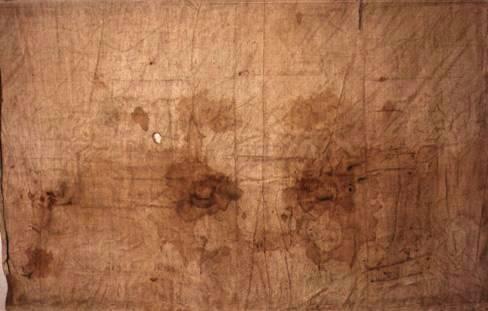
The cloth was not wrapped entirely round the head because the right cheek was almost touching the right shoulder. This suggests that the sudarium was put into place while the body was still on the cross. The second stain was made about an hour later, when the body was taken down. The third stain was made when the body was lifted from the ground about forty five minutes later. The body was lying at the foot of the cross for about forty-five minutes before being buried. The marks (not fingerprints) of the fingers that held the cloth to the nose are also visible.
The experiments with the model head and the study of the stains also show that when the man died his head was tilted seventy degrees forward and twenty degrees to the right. This position further suggests that the man whose face the sudarium covered died crucified.
There are smaller bloodstains at the side of the main group. It would appear that the sudarium was pinned to the back of the dead man's head, and that these spots of blood were from small sharp objects, which would logically be the thorns that caused this type of injury all over Jesus' head.
The medical studies are not the only ones that have been carried out on the sudarium. Dr. Max Frei analysed pollen samples taken from the cloth, and found species typical of Oviedo, Toledo, North Africa and Jerusalem. This confirms the historical route described earlier. There was nothing relating the cloth to Constantinople, France, Italy or any other country in Europe.
An international congress was held in Oviedo in 1994, where various papers were presented about the sudarium. Dr. Frei's work with pollen was confirmed, and enlarged on. Species of pollen called "quercus caliprimus" were found, both of which are limited to the area of Palestine.
Residues of what is most probably myrrh and aloe have also been discovered, mentioned directly in the gospel of john, 19:39-40, "Nicodemus came as well...and he brought a mixture of myrrh and aloes...They took the body of Jesus and bound it in linen cloths with the spices, following the Jewish burial custom."
The stains were also studied from the point of view of anthropology. The conclusion was that the face that had been in contact with the sudarium had typically Jewish features, a prominent nose and pronounced cheekbones.
Finally, the very fact that the cloth was kept at all is a sign of its authenticity, as it has no artistic or monetary value at all. All the studies carried out so far point in one direction, with nothing to suggest the contrary the sudarium was used to cover the head of the dead body of Jesus of Nazareth from when he was taken down from the cross until he was buried.
3: Coincidence with the Shroud
The sudarium alone has revealed sufficient information to suggest that it was in contact with the face of Jesus after the crucifixion. However, the really fascinating evidence comes to light when this cloth is compared to the Shroud of Turin.
The first and most obvious coincidence is that the blood on both cloths belongs to the same group, namely AB.
The length of the nose through which the pleural oedema fluid came onto the sudarium has been calculated at eight centimetres, just over three inches. This is exactly the same length as the nose on the image of the Shroud.